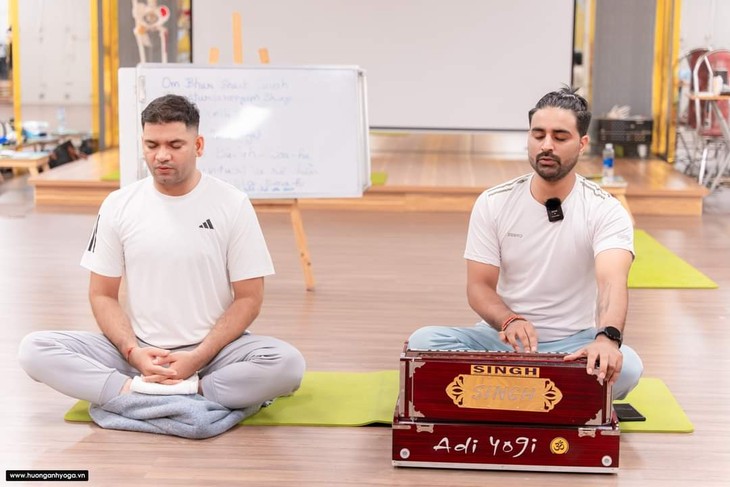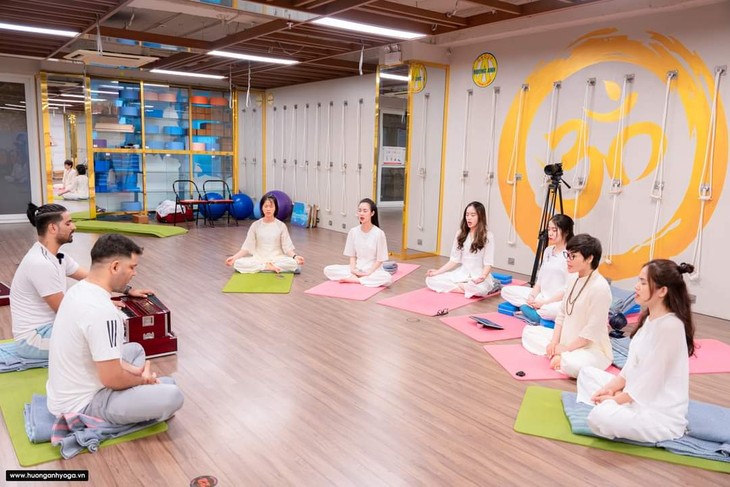(VOVWORLD) - Mantra yoga is seen as one of the easiest ways to achieve the difficult state of internalizing the sense-oriented mind from the external world and focusing on inner consciousness. In Vietnam, more and more people are practicing mantra yoga and consider it a way to relieve the body and mind from daily stress. In this week’s Cultural Rendezvous, Indian yoga master Virender Singh, who has 5 years’ experience teaching yoga in schools in India and 5 years teaching yoga in Hanoi, will give us an insight into this kind of meditation and how to practice it most properly.
 Yoga master Virender (R) and his colleague co-teach a meditation class. (Photo credit: Virender Singh) Yoga master Virender (R) and his colleague co-teach a meditation class. (Photo credit: Virender Singh)
|
Bao Tram: Thank you, Virender, for joining us on VOV24/7’s Cultural Rendezvous. One more thing I want to explain to you all. This is my yoga teacher. Nice to talk to you today instead of practicing with you as usual.
Virender Singh: Xin chao Vietnam! I’m honored to have this opportunity to introduce mantra yoga, one of my country’s cultural identities.
Bao Tram: Well, I notice that at the beginning of a yoga class, you always ask us to chant OM, a kind of mantra. So tell us exactly what is mantra yoga?
Virender: Mantra yoga is a meditation practice that focusses on chanting, conscious breathing, and meditation to quiet the mind. The practice of chanting mantra is one of the easiest and most powerful ways of meditation. When we repeat a mantra again and again, we focus that energy inward, leading us to our deeper gain, the greater mystery of our mind. In mantra yoga, the practitioner chants a particular mantra repeatedly to create a meditative state which can be used for spiritual purposes and to connect with the Divine.
Bao Tram: As you mention the spiritual purpose and the connection with the Divine, I’m wondering how mantra yoga came into being. Anything relating to religion?
Virender Singh: The origin of mantra yoga has been traced back to the Vedas and Tantras. Facts indicate that yoga actually came into being in the form of mantra yoga. The primary teachings of it are mentioned in the Rig Veda. Mantra yoga is much more than a spiritual practice with the sound of universal consciousness which leads the practitioners to the Divinity. Originally, mantra yoga was developed in Hinduism, but other religions like Buddhism, Jainism, and Sikhism also adopted it.
Bao Tram: So how many types of mantra chanting are there?
Virender Singh: There are fourteen types of chanting in mantra yoga like speed chanting, low pin chanting, mental chanting, japa, chanting, brahmar chanting, prada kasina chanting, and prohibited chanting. As there are many different kinds of chanting, I will give you some examples. Speed chanting is the practice of chanting in the mantra loudly and focusingcompletely on the sound. It removes thoughts, and stabilizes the mind to reach meditative states, and that is especially helpful for the beginners. Another type of mantra chanting is low pin chanting. It is the way of mantra yoga that is audible to practitioners only, as the chant only involves just a lower lip movement while chanting. Another type is mental chanting, in which the mantra is chanted silently in the mind without creating any sound or any lip movement. This is usually practiced by advanced yogis. I just explained three types of chanting, speed chanting, low pin chanting, and mental chanting.
Bao Tram: Of these methods, which one do you use most while teaching yoga?
Virender Singh: As all yogis in Hanoi, we just chant a small mantra which is called OM. OM is a most powerful sound. It’s not just a sound, you can say it’s a wave of the universe. OM is the most powerful sound that lies within us. Practicing the Om chanting helps our mind and body to energize. The sound of OM in Buddhism, Hinduism, Sikhism and Jainism is called the first sound of the universe. According to the Hinduism, OM connects all the living beings to the nature and the universe. You can chant OM silently or loudly. There are many benefits of OM chanting, for example OM chanting is very good for stomach. It calms your mind, reduces stress and anxiety, and has other health benefits.
 In a Virender’s class (Photo credit: Virender Singh) In a Virender’s class (Photo credit: Virender Singh)
|
Bao Tram: As I observed yoga centers, an increasing number of people, mostly at their 30s or even younger, are turning to meditation to seek peace of mind. Could you elaborate on the health benefits of mantra yoga?
Virender Singh: Mantra can have most powerful effects on the mind, body, spirit, and the emotions. Mentally, mantra yoga increases concentration and improves our memory and focus. And the mantra yoga meditations give us a lower heart rate, reduces blood pressure and the relaxation response for healing. It also builds self-confidence and reduces stress while balancing the emotions. And there I want to give some more practice tips like focussing on the feelings of the mantras in your body. Be mindful of where the sound vibrations resonate in your head, chest, and body. Let the mantra flow naturally without forcing it. Don't get caught up in thinking about what you should think or how you should pronounce the mantra. Just do your best with pure intentions. When you feel distracted, gently bring your awareness back to the mantra. Start with a mantra that is simple and short, and add more complexity and chanting with the Gayatri mantra. Gayatri mantra is the most powerful mantra. After you feel comfortable with the practice I want to tell you about Gayatri mantra how it chants om (He demonstrates the chanting….) … You can repeat that mantra…. In starting, you can choose any short mantra. OK… at first practice every day for 3 to 5 minutes, then slowly increase your time as you get comfortable with the practice. The best time to practice the mantra chanting is in the early morning or the evening time. When you chant mantras, pay attention to your breath and increase your focus. When you finish the chanting and repeating of the mantras, take a few moments to reflect. Like when you finish chanting and just sit comfortably and look into your body, your mind, your heart where it is affecting you. When you finish chanting then just sit comfortably relaxing and just look into the body and feel the vibrations where it is affecting your mind, body and your heart. Mantras are used for many purposes including healing, meditation, personal growth, and prayer. Your breath of the vibration of sound mantras helps you to go deeper in the mind, connecting you to the higher self and the divine.
Bao Tram: Show us how to chant mantras in a correct way.
Virender Singh: You can chant mantras anywhere, anytime, or for any length of time. It is important to understand the technique and the methods before starting. First of all, to start chanting mantras, sit in a comfortable position with the eyes closed and slowly repeat the word. Be careful. Pay attention to the speed and the rhythm of your chanting. Make sure you are chanting a correct mantra. Pronunciation should be clear. Your mind should be focused on the mantras and slowly, slowly keep chanting, keep chanting with deep breaths and exhalation. Chant the mantras while exhaling. Take deep breaths and repeat the mantra continuously and feel the moment. You need to relax the mind and the body and feel the sound and the vibration of the mantras. Repeat again and again, combining all the elements together, focusing on the sound and meaning of the mantra and easing your expectations. Keep chanting about, if you can, continuously chant about 30 rounds or until you calm your mind within the practice. Keep chanting. Sit in the complete silence that you have generated with the chant and cleansing the nervous system. Mantra yoga can also be done in groups with one instructor or leader who can introduce mantras to you and teach you the techniques.
Bao Tram: Thank you, Virender Singh, for granting VOV this interview and explaining to our listeners about mantra yoga, especially how to chant mantras properly.
Virender Singh: Thank you very much for giving me this opportunity to connect with your listeners.